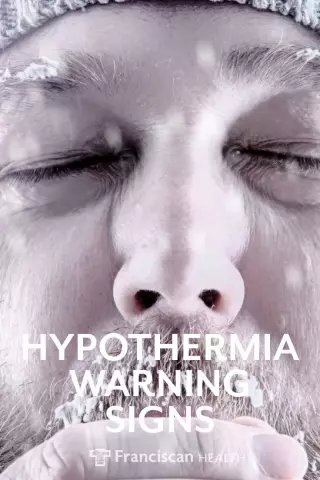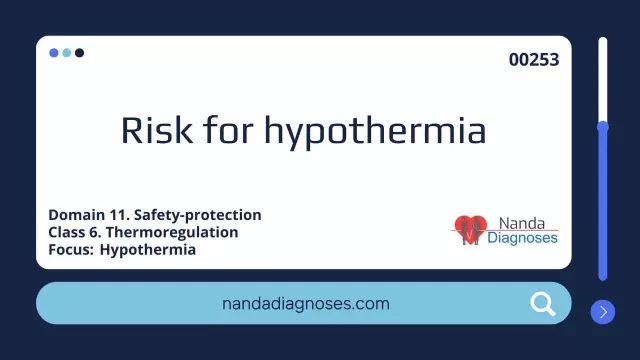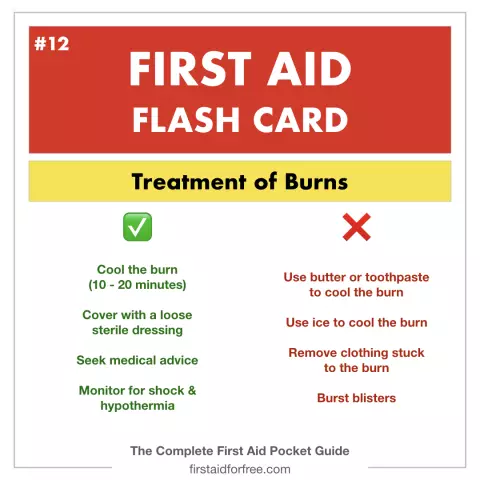- Author Rachel Wainwright [email protected].
- Public 2023-12-15 07:39.
- Last modified 2025-11-02 20:14.
Hypothermia

The human body is able to withstand a lot, but there are boundaries that are undesirable to cross because of the possible tragic consequences. One of the factors provoking disruption of human life is the low temperature of the ambient air. If a person is exposed to cold for a long time, he may develop hypothermia of the body, in which the body temperature drops to critical figures and a disruption occurs in the work of all organs and systems.
The most susceptible to general hypothermia are young children, the elderly, forcedly immobilized, physically exhausted, unconscious people. The course of the disease is aggravated by strong wind, high humidity, overwork, damp clothing, injuries, alcohol or drug intoxication.
Hypothermia of the legs and the whole body can be obtained even when swimming in a cool reservoir, the consequences will depend on the duration of stay in the water at such a temperature.
Signs of hypothermia
It's not that hard to recognize. At first, a person experiences a surge of strength, he is overly excited, but at the same time there is a cyanosis of the nasolabial triangle, pale skin. The patient is worried about severe chills, shortness of breath, frequent pulse.
If no therapeutic measures are taken during this period, excitement is replaced by apathy, lethargy, lethargy. A person loses the ability to move, weakness and drowsiness seizes him, and a loss of consciousness is often observed. Failure to provide help for hypothermia leads to the cessation of cardiac and respiratory activity, as a result of which the person dies.
Hypothermia
Depending on the patient's condition, there are three degrees of hypothermia:
1. Lightweight. The body temperature is reduced to 32-34 degrees. The patient has chills, pale skin color, bluish tint of the lips and nasolabial triangle, "goose bumps", a person can hardly speak due to trembling of the lower jaw and lips. Blood pressure with a mild degree of hypothermia remains within normal limits, sometimes slightly increases. The patient is able to move independently. At this stage, the appearance of foci of frostbite of 1-2 degrees is possible.

2. Average. There is a further decrease in body temperature, it can reach 29-32 degrees. The skin becomes cyanotic and becomes cold to the touch. The patient is seized by indifference to what is happening, apathy and drowsiness. With general hypothermia, a state of "numbness" is observed, in which the patient does not respond to directed speech and other external stimuli.
Blood pressure decreases slightly, there is a slowdown in the pulse, while breathing becomes more rare. The ability to move independently is lost. Frostbite can be up to the fourth degree. Lack of help with hypothermia in the middle stage leads to the development of various complications, in some cases to the death of the patient.
3. Severe. The human body temperature drops below 31 degrees, while loss of consciousness is observed, the pulse slows down to 30-35 beats per minute. With general hypothermia, the skin and mucous membranes become pronounced cyanotic, swelling of the face, lips, hands and feet appears. The patient loses consciousness, convulsions appear, the condition is aggravated by the transition to a coma. Blood pressure drops sharply, breathing becomes very rare. Frostbite at this stage of general hypothermia is quite severe. A person needs emergency medical care, otherwise he will be fatal.
First aid for hypothermia
First aid for hypothermia consists in stopping the effect of the cold factor on the human body. For this, the victim must be brought into a warm room or, if this cannot be done, laid in a place protected from wind and precipitation. Wet clothes should be immediately disposed of, after which the patient should be wrapped in dry underwear or a blanket. If hypothermia of the legs or head is noted, it is enough to take off your wet shoes and put something warm on your head.
If a person is conscious, it is necessary to give him hot milk, fruit drink, water or tea to drink. With general hypothermia, it is advisable to take a bath, first with warm water, and then hotter, but not higher than 40 degrees. After water procedures, the victim is placed in a warm bed and covered with heating pads or bottles of hot water. Frostbite areas should be covered with clean, preferably sterile, dressings.
In an unconscious patient, it is necessary to monitor the presence of respiration and pulse. In the absence of such, you should immediately start chest compressions and artificial respiration.
After providing first aid, a person who has suffered from hypothermia must be taken to the hospital, even if at first glance his condition is satisfactory. Some complications can only be identified by a doctor.
What not to do with hypothermia
In order not to cause even more harm, it is impossible to give the sick person coffee and alcoholic beverages. It is not recommended to place a person in hot water without first warming up. In case of hypothermia, it is forbidden to intensively rub the skin with snow, oil, alcohol-containing liquids or simply dry hands, as well as pierce the bubbles formed at the site of frostbite. An open fire must not be used to heat the victim. The use of these methods leads to a sharp temperature drop, which is fraught with damage to small capillaries, the appearance of internal hemorrhages and other, no less severe complications.
Prevention of hypothermia

- Children should wear clothing that is large enough and appropriate for the season. It is not recommended to tie a scarf over your mouth and nose to avoid exposing your face to moist and cold air. Mittens and socks must be dry. On frosty days, the child needs to go into a warm room every 15-20 minutes to keep warm.
- Adults should always wear a scarf, hat and mittens. You can't go out into the cold with damp hair.
- It is advisable to dress in such a way that several thinner garments are worn than one, but dense and heavy. The air gap saves from premature hypothermia. Shoes also should not be tight or wet.
- It is not recommended to smoke in the cold, as a smoked cigarette leads to a decrease in peripheral blood circulation.
- Do not moisten with liquids or lubricate your face with moisturizer before going outside.
- During a walk, you must vigilantly monitor your well-being. At the first signs of hypothermia, you need to go into a warm room.
The preventive measures taken will allow, if not to avoid hypothermia altogether, then at least to significantly reduce its negative effect on the body.
YouTube video related to the article:
The information is generalized and provided for informational purposes only. At the first sign of illness, see your doctor. Self-medication is hazardous to health!






